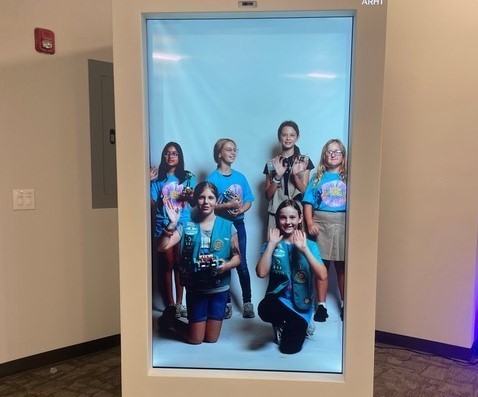Teaching with Holograms: The Next Level of Immersive Edtech
Hologram lessons outperformed virtual reality and web lessons on 3D printing at the Florida Institute of Technology.

Recently, students learning about 3D printing and design at Florida Institute of Technology’s Center for Advanced Manufacturing and Innovative Design were randomly split into three groups. One group received the lesson via an online platform, another learned via virtual reality, and a third group watched a lesson delivered via hologram.
The students who received the hologram lesson did better than their online and VR counterparts.
“We had a better retention rate for holographic displays and also better engagement,” says Marifer Sagastume Hurtado, Community Coordinator and STEM Designer for Florida Tech’s Center for Advanced Manufacturing and Innovative Design (CAMID).
Holograms are the latest science fiction-sounding tech innovation to start making its way into classrooms and STEM centers around the globe. The hologram technology Florida Tech utilizes is a hologram capsule made by ARHT. Taller than a refrigerator, these capsules look like giant smartphones and can create the illusion of 3D videos of people, places, or things that appear within the screens/display areas.
In addition to college students, Hurto says, the hologram capsule has been used successfully as a teaching tool with K12 students visiting CAMID during summer camp.
Teaching With Holograms
Holograms can present visual and even tactile material to students. Florida Tech’s lesson involved a 3D video of a 3D printer. “You can see it and you can see all the settings as well,” Hurtado says.
The technology can also be used to pre-record lifelike lectures from presenters that are much more immersive than a standard video. Perhaps most futuristic of all, holograms can even be used to “teleport” a speaker in real-time, assuming a person has the proper video-capture tools on the other end. Hurtado has spoken with educators in Canada who have beamed into her Florida capsule.
Tech & Learning Newsletter
Tools and ideas to transform education. Sign up below.
“I could have one of them come and talk to an audience,” she says. “We haven't tried that yet, but we're gonna definitely be exploring those capabilities in the next months. We call it Zoom on steroids.”
Jeanne Weber, VP of Global Education for ARHT, says this is powerful usage of hologram technology that has many advantages over traditional video calls. “With a hologram, you're seeing somebody head to toe," she says. "You're seeing all of their body movements and body language, all of their facial expressions. You're interacting with them, just as if they're standing right there in front of you. Even after several minutes, you start to build that emotional engagement with the person who's beaming in as the hologram. It's just so much more impactful than a flat or 2D type of platform.”
Other Teaching Opportunities and Advice
Colleagues of Hurtado’s at Florida Tech are exploring integrating hologram technology with some type of AI-powered assistant to create a 3D avatar that can interact with students in a way that would be similar to how ChatGPT interacts, but not limited to text. Hurtado also hopes to have recorded welcoming messages from various university officials recorded to play on the hologram capsule and greet visitors to CAMID.
Weber says discussions are in the works to use ARHT technology for K12, including for special education and professional development for teachers.
Hurtado says that for educators who can purchase the technology, it’s a great learning tool and can lead to expanded teaching practices. In order to create high-quality 3D videos Hurtado says she has begun working with people from the entertainment industry.
“Educators opening up and working and collaborating with other professionals in other fields, I think it's very good and it's just important to be open to it," she says. "There's just so many cool things that you can create if you give yourself the opportunity.”
Erik Ofgang is a Tech & Learning contributor. A journalist, author and educator, his work has appeared in The New York Times, the Washington Post, the Smithsonian, The Atlantic, and Associated Press. He currently teaches at Western Connecticut State University’s MFA program. While a staff writer at Connecticut Magazine he won a Society of Professional Journalism Award for his education reporting. He is interested in how humans learn and how technology can make that more effective.










